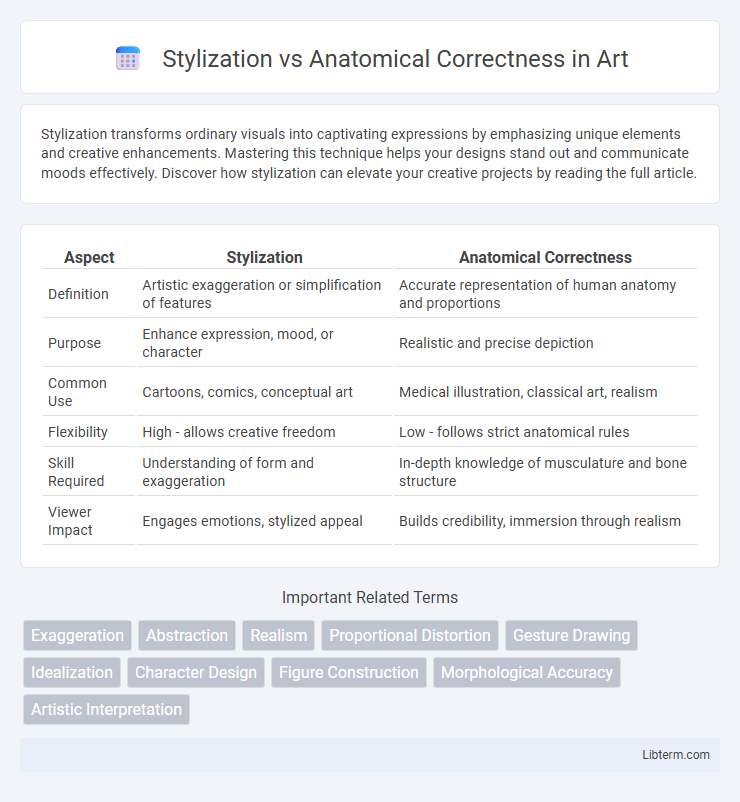Stylization transforms ordinary visuals into captivating expressions by emphasizing unique elements and creative enhancements. Mastering this technique helps your designs stand out and communicate moods effectively. Discover how stylization can elevate your creative projects by reading the full article.
Table of Comparison
| Aspect | Stylization | Anatomical Correctness |
|---|---|---|
| Definition | Artistic exaggeration or simplification of features | Accurate representation of human anatomy and proportions |
| Purpose | Enhance expression, mood, or character | Realistic and precise depiction |
| Common Use | Cartoons, comics, conceptual art | Medical illustration, classical art, realism |
| Flexibility | High - allows creative freedom | Low - follows strict anatomical rules |
| Skill Required | Understanding of form and exaggeration | In-depth knowledge of musculature and bone structure |
| Viewer Impact | Engages emotions, stylized appeal | Builds credibility, immersion through realism |
Understanding Stylization in Art
Stylization in art emphasizes exaggeration, simplification, and abstraction to convey emotion and narrative over strict anatomical accuracy. This approach allows artists to prioritize visual impact and thematic expression, often enhancing character personality and mood through altered proportions and shapes. Understanding stylization involves recognizing how deliberate distortion serves as a creative tool for storytelling and artistic identity beyond realistic representation.
Defining Anatomical Correctness
Anatomical correctness refers to the accurate representation of the human body's structure, including proportion, muscle placement, bone alignment, and joint articulation. It ensures that figures adhere to real-world biological standards, facilitating realism and believability in art and animation. Mastery of anatomical correctness enhances the artist's ability to depict natural poses, movements, and expressions with precise spatial relationships.
Historical Perspectives: Art Movements and Anatomy
Historical perspectives on stylization versus anatomical correctness reveal distinct art movements prioritizing expressive form over precise anatomy, such as Expressionism and Cubism, which intentionally distort human figures to convey emotion or abstract concepts. In contrast, the Renaissance epitomized anatomical correctness, driven by artists like Leonardo da Vinci who studied human anatomy through dissection to achieve realistic representation. This dichotomy underscores a long-standing tension in art between creative interpretation and scientific accuracy, shaping the evolution of figure depiction across centuries.
The Appeal of Stylization in Modern Media
Stylization in modern media enhances visual storytelling by prioritizing expressive shapes and exaggerated features over strict anatomical accuracy, creating memorable and emotionally engaging characters. This approach allows for unique artistic identities and stronger audience connection through iconic, easily recognizable designs. The appeal of stylization lies in its flexibility to convey personality and mood, often outperforming anatomical correctness in narrative impact.
Challenges of Achieving Anatomical Accuracy
Achieving anatomical accuracy in art presents challenges such as mastering complex human proportions, understanding muscle structure, and accurately depicting joint articulation. Artists must reconcile the natural variability found in human bodies with the need for precise detail, making it difficult to maintain both realism and expressive intent. Reliable anatomical references and rigorous practice are essential to overcoming these obstacles and producing lifelike representations.
Balancing Creativity and Realism
Balancing creativity and realism in stylization versus anatomical correctness involves understanding the core principles of human anatomy while allowing artistic freedom to exaggerate or simplify forms. Effective stylization maintains recognizable anatomical landmarks, ensuring characters feel believable even when proportions or features are distorted for artistic effect. This combination enhances visual storytelling by merging imaginative design with grounded, relatable structures.
When to Prioritize Stylization
Prioritize stylization when aiming to evoke strong emotions, create a unique artistic identity, or simplify complex forms for enhanced visual storytelling. Stylization allows for exaggerated features and proportions that can communicate mood, character traits, or cultural aesthetics more effectively than strict anatomical accuracy. This approach is essential in animation, illustration, and graphic design where expressive impact and viewer engagement outweigh realistic representation.
When Anatomical Correctness Matters Most
Anatomical correctness matters most in fields like medical illustration, forensic art, and realistic character modeling where precision is critical for accurate representation and communication. In these contexts, detailed knowledge of human anatomy ensures that depictions align with true biological structures, enhancing the efficacy of education, diagnosis, and identification. Accurate anatomy supports credibility and trust, especially in professional and scientific settings where visual accuracy impacts outcomes and decision-making.
Notable Artists: Masters of Stylization and Anatomy
Notable masters of stylization such as Gustav Klimt and Egon Schiele are renowned for their expressive, exaggerated forms that emphasize emotional depth over strict realism. In contrast, anatomical correctness is epitomized by artists like Leonardo da Vinci and Michelangelo, who meticulously studied human anatomy to achieve lifelike precision and dynamic poses. These distinct approaches highlight the balance between creative interpretation and scientific accuracy in art.
Tips for Artists: Blending Stylization with Accurate Anatomy
Artists achieve effective stylization by first mastering fundamental anatomical structures, ensuring proportional accuracy in key body parts such as the ribcage, pelvis, and limbs. Emphasizing gesture and exaggeration helps maintain dynamic poses while respecting anatomical logic, allowing creative freedom without sacrificing believability. Utilizing reference materials and iterative sketching techniques supports a balanced approach, blending expressive stylization seamlessly with anatomical correctness.
Stylization Infographic

 libterm.com
libterm.com